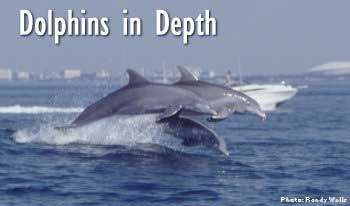
COVERING TAMPA BAY AND ITS WATERSHED |
Our subscribe page has moved! Please visit baysoundings.com/subscribe to submit your subscription request. |
||||||
|
By Mary Kelley Hoppe Bottlenose dolphins don't need Dorothy to tell them 'there's no place like home.' They tend to remain strongly rooted to a specific home range or bay, says researcher Randy Wells, whose multi-generational study of Sarasota Bay's wild dolphins dates back to 1970, when Wells was a teenage intern at Mote Marine Laboratory. Thirty-five years later, the work that Wells began is now the world's longest-running study of wild dolphins, seminal research that continues to yield important information about these complex and engaging creatures. "There's nothing simple about them," Wells says, marveling at the result of 65 million years of evolution. While these cetaceans have delighted mariners for ages, relatively little was known, until recently, about their life in the wild. "In 1970," says Wells, "most of what people knew about dolphins had been learned from captive animals." Working with Blair Irvine, Wells set out to change that. Irvine, then a researcher at Mote, was studying the behavior of sharks and dolphins, and training dolphins to keep sharks away from divers. "We got permission to tag dolphins 'in our spare time,'" Wells recalls. "We didn't know whether bottlenose dolphins in Sarasota Bay stayed in that area or roamed all over the west coast of Florida." The answer to that was the key to everything else. "Once we knew we had a predictable set of dolphins we could work with," he explains, "we could study an identifiable population over time." Wells now heads the Sarasota Dolphin Research Project he and Irvine initiated. Through a collaborative effort between the Chicago Zoological Society and Mote, Wells and his colleagues have documented the movements of nearly 150 dolphins in the 40-square-mile area of Sarasota Bay. Overall, the project study includes 2,500 recognizable animals ranging from Tampa Bay south to Charlotte Harbor. A primary focus of the research is to better understand the structure and dynamics of dolphin populations, and the threats facing them. The goal is to inform conservation policies and practices. When Wells and Irvine began their long-term studies, people believed that bottlenose dolphins lived about 25 years. They discovered that some dolphins live 50 years or more, and that females can successfully bear calves into their late forties. In fact, while female dolphins reach sexual maturity as early as five years of age, calf survival is greatest for experienced dolphin moms over the age of 40.
One grand-calf, Merrily, was rescued by researchers at nine months of age after becoming entangled in fishing net. Another sister, FB3, suffered deep cuts to her tail fluke from a 1600-foot bundle of heavy-gauge fishing line. Wells' crew was finally able to get a hook into the line and cut most of it free. "She spent the next half-hour riding at the bow of our boat," Wells says. "It was one of the strangest things we'd ever had happen." Male bonding One of the more curious predictors for male breeding success in bottlenose dolphins is male pair bonding. As males reach maturity, many form long-term bonds with other males - decades-long relationships that outlast mother-calf bonding. While both unpaired and paired males sire young, paired males sire disproportionately more calves than unpaired males. While the social pairing is unusual among mammals, researchers point to several advantages, from highly effective tag-team feeding to protection from predatory sharks. Bonded males may also improve mating opportunities as the pair works together to access receptive females or ward off unwelcome suitors. Emerging contaminants Ongoing studies of the impact of environmental contaminants including PCBs and DDT on dolphin health show a pattern of bioaccumulation in the animals. But while chemical levels in males continue to rise, females "cleanse" themselves by lactating, passing contaminants to their offspring. Some males in the Sarasota study group registered PCB levels of over 800 parts per million - professionals consider 1 to 10 ppm to be of concern in humans. That might explain the lower life expectancy for males, which rarely survive beyond age 40. At the other end of the spectrum, first-born calves have a higher concentration of PCBs than those born later, and they experience higher mortality. Wells wonders if there is a correlation. "What may not be toxic for a 400-pound female may be for a 40-pound calf." "There's not going to be a smoking gun," Wells cautions, no simple cause and effect. What scientists can do is build a strong correlational trail of evidence that leads to improved management protection. Right now, says Wells, management agencies focus on human impacts to fisheries, but not marine mammals. "We're trying to give them more to work with."
|
|||||||
|
|||||||
|
© 2004 Bay Soundings
|
|||||||
 Sarasota Dolphin Research Project
Sarasota Dolphin Research Project Wells recalls a milestone in 1982 when Genie - a dolphin named for the grand dame of shark research, Dr. Eugenie Clark - gave birth to a calf. Wells met Genie's mom, Granny, a decade earlier; her grand-calf marked three generations of animals under study. Today, Granny's great-grand-calves are roaming the bay, though Genie and Granny, who died at age 50, have passed on.
Wells recalls a milestone in 1982 when Genie - a dolphin named for the grand dame of shark research, Dr. Eugenie Clark - gave birth to a calf. Wells met Genie's mom, Granny, a decade earlier; her grand-calf marked three generations of animals under study. Today, Granny's great-grand-calves are roaming the bay, though Genie and Granny, who died at age 50, have passed on.